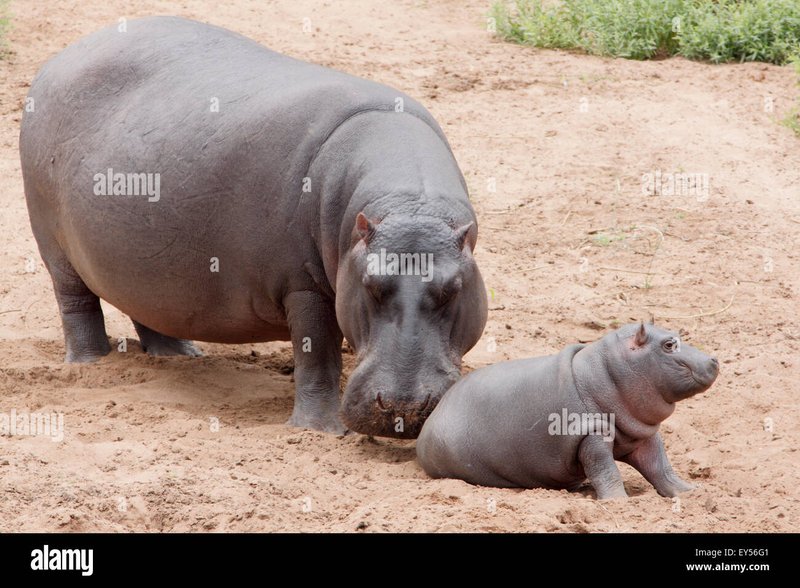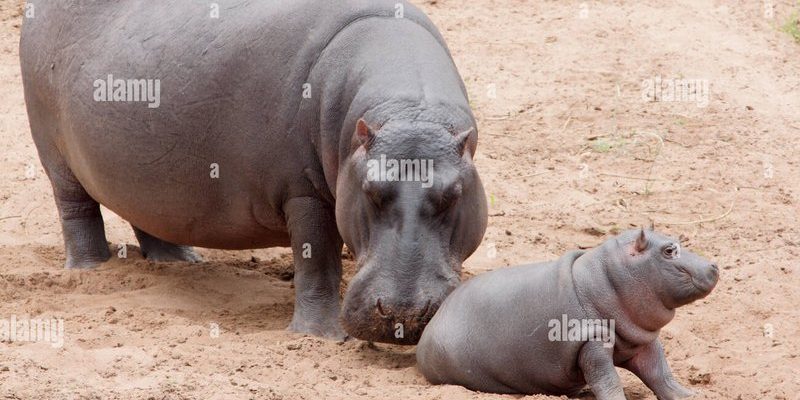
Imagine being a hippo calf in a big, muddy river, surrounded by other giants. The world feels vast and intimidating, but your mother is your safe haven. Hippos are known to be protective parents, and their childcare strategies are as interesting as the animals themselves. So, let’s dive into how hippos raise their young, exploring everything from their social structures to their nurturing techniques.
The Role of Mothers in Hippo Care
When a baby hippo is born, the mother plays a central role in its early life. Generally, hippos give birth to one calf at a time, though twins can happen, they’re rare. After a gestation period of about eight months, a mother carefully brings her newborn into the world, typically in shallow water. This immediate connection to the water is essential since baby hippos are born underwater and instinctively swim to the surface for their first breath.
Here’s the thing: hippo mothers are incredibly protective. They’ll keep their calves close by, often exposing them to the sun on riverbanks. Hippo moms will take turns swimming with their calves while keeping a watchful eye on predators. You might be wondering how they manage this—hippos have a unique skill. Their eyes, ears, and nostrils are positioned on the top of their heads, allowing them to see and breathe while mostly submerged. This wonderful adaptation helps mothers keep their babies safe while they enjoy the water.
Social Structures: The Importance of Family
Hippos are social animals and often live in groups called pods, which can have anywhere from ten to thirty members. These pods usually consist of females and their young, led by a dominant male. This social structure plays a crucial role in raising young hippos. The more eyes watching a calf, the safer it feels, and a strong community helps teach it essential survival skills.
Interestingly, the females in a pod will often help each other with childcare. If a mother needs a moment to forage or rest, another female might step in to supervise the young ones. This cooperative care system allows hippo mothers to balance their needs while ensuring their calves are always watched over. It’s a little like a neighborhood watch for hippos, where everyone chips in to help raise the next generation.
Nurturing Behavior: Feeding and Protection
After their calves are born, hippos have to ensure they’re well-fed. Though hippos are primarily herbivorous, munching on grasses during the night, calves rely on their mother’s milk for the first several months of life. A hippo calf will nurse frequently, and mothers are known to be quite attentive during this stage. They’ll often stay in shallower waters to make feeding easier and more comfortable for their young.
Protection is also key during this phase. Female hippos are notorious for their fierce defense of their young. If a perceived threat appears—even from another hippo—mothers are known to charge at intruders to defend their calves. They understand that in their world, danger is always lurking, so their protective instincts kick in whenever necessary. This fierce maternal nature helps ensure the survival of their species.
Learning to Swim: The First Steps
As calves grow, learning to swim becomes one of their biggest milestones. Though they are born with the ability to swim, it takes time to master the skills necessary for survival. Mothers will encourage their calves to venture into deeper waters while always remaining close by to guide them.
Calves will practice swimming by diving and resurfacing, often mimicking their mothers. This is a bonding time, filled with play and learning. Honestly, watching a mother hippo teach her calf to swim can feel like seeing a mother teaching her child to ride a bike for the first time—there’s lots of excitement, a bit of wobbling, and of course, a few cuddles for encouragement.
Independence: Transitioning to Adulthood
As calves grow older, they gradually begin to gain independence. By the time they’re about six months old, they’ll start grazing on grass along with their mothers. This transition is crucial, as it teaches calves not only how to find food but also how to navigate the social dynamics within their pod.
Hippo calves often stay with their mothers for about four years, learning essential skills like recognizing threats and understanding their territory. During this time, they witness their mothers interacting with others, which informs their behavior as they eventually mature into adults. By the time they reach the age of five, many hippos are ready to establish their own territories and may even start families of their own.
Challenges in the Wild: Survival of the Fittest
Despite their fierce parenting style, raising young hippos isn’t without challenges. Predators like crocodiles and lions pose a constant threat to calves, making it essential for mothers to stay vigilant. Even in a protective pod, the risk is always present.
Moreover, environmental changes can impact their habitats and food sources. Droughts, habitat destruction, and human encroachment can lead to reduced water supplies, putting pressure on hippos as they try to raise their young. It’s a harsh reality that reminds us that while hippos may seem invincible, they too are affected by the world around them.
Why Studying Hippo Parenting Matters
Understanding how hippos raise their young offers valuable insights into their behavior and ecology. By studying their nurturing practices, conservationists can advocate more effectively for their habitats and welfare. It’s essential to preserve these majestic creatures and ensure future generations can thrive in the wild.
Plus, learning about hippos helps us appreciate the complex relationships and behaviors of different animals. Each species has its own unique parenting style, and hippos certainly display some of the most fascinating. From protective mothers to supportive pods, there’s a lot to admire in their approach to family life.
As we wrap up, it’s clear that hippos are more than just large, lazy animals floating in rivers. They are devoted parents, protective of their young, and deeply social creatures. As we continue to learn about them, we also discover the importance of conserving their habitats for generations to come. Their survival not only ensures that we continue to see these amazing animals but also contributes to the health of their ecosystems. So next time you think of hippos, remember it’s not just about their size; it’s about their incredible journey of raising their young in the wild.

